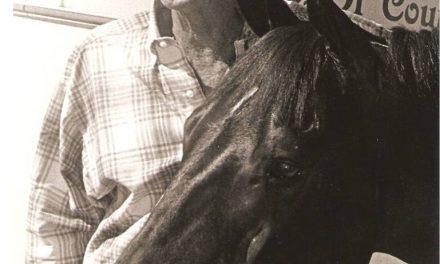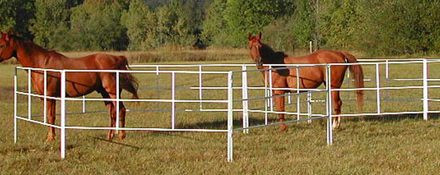A Horse, Of Course
 Believe me, bits are simple.
Believe me, bits are simple.
There are only two kinds. (There are plenty of variations.)
Neither kind of bit can work miracles.
Both kinds can be used to inflict pain. At the same time many advertisements state their bit will never cause the horse any discomfort, and will solve training problems. Impossible!
Ask most horsemen and you’ll be surprised to discover few know much about bits. Few can give an accurate definition of either kind. Worst of all, few know how the bit they are using actually works.
The two kinds of bits are the snaffle and the curb. What’s the difference? A snaffle has the reins attached opposite the mouthpiece, and has no curb action and no pool action. The snaffle is a direct action bit. A curb has the reins attached below the mouthpiece, so there is a lever and fulcrum effect. A curb has both curb and poll action.
Notice I did not mention the type of mouthpiece in either bit. That is because the type of mouthpiece does not define the bit. (You constantly hear that a snaffle is a bit with a jointed mouthpiece. Not true. A snaffle can have any type of mouthpiece you desire.)
A snaffle—with any kind of mouthpiece—requires the use of two hands on the reins in order for it to function efficiently. While the rider holds one rein steady, the other rein is bumped, thus causing the mouthpiece to press against the bar of the mouth on other side. The pressure causes discomfort and the compliant horse gives in order to avoid the irritation.
You can come up with all the humane sounding jabberwocky you want, but the truth is the truth. Bits function on the theory the horse complies in order to avoid discomfort or pain.
The shanks of a curb bit cause a lever action, which moves around a fulcrum (the mouthpiece) and create pressure in the chin groove and at the poll. In addition, depending on the mouthpiece, pressure can be applied to the tongue, bars and possibly the roof of the mouth.
Bits were invented about 1,000 B.C., starting out as a thong through the mouth or around the lower jaw. The idea was to inflict enough pain that the horse would comply with the handler’s desire rather than put up with continued discomfort.
As technology advanced, bits became much more severe and painful, especially with the advent of the martingale. The martingale allowed horsemen to apply great downward pressure to mouthpieces that were discs, spikes and chains. The Greeks were using such torture devices, as well as a version of the modern roller bit, as long ago as 500 B.C.
Not much has changed since then. Horsemen still love the idea of a bit that will solve their training problems. Seldom does the average horseman take time to understand the bit that is being used.
So called “training bits”, the “Tom Thumb” and “cowboy snaffles” are extreme pain producers. The shanked lever-action coupled with the jointed mouthpiece produces a nutcracker effect in the mouth, along with poll and curb pressure. They are cruel bits.
At the same time we must acknowledge that is it the horseman, not the bit, who inflicts the pain.
Xenophon, the first to write a complete book on horsemanship around 400 B.C., made an observation that is true today: It is not so much how severe the bit, but how light the hand.
And a hand is light when it applies minimal pressure to communicate a desire, and that pressure is momentary, followed by an immediate release of the pressure.
All bits and all communication should be employed in the same manner: light pressure to ask for a response, then an immediate release of pressure. If the desired response is not forthcoming from the horse, the request is made again, followed by an immediate release. The request is repeated until the horse responds correctly, at which time he should be praised for his action. That is communication, which is horse training.
Any claim that a bit is going to solve training problems, reduce resistance, give more comfort, control the rogue, or get the horse to swim on his back while whistling Dixie is bunk.
Bits do what they do.
Good horsemen learn how they work and why, and then use them in the least abusive way.
Visit www.horsecoursesonline.com to earn certification as a horse trainer, riding instructor or stable manager, or work toward a Bachelor of Science degree in Equine Studies. All courses online.



